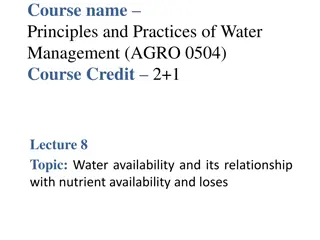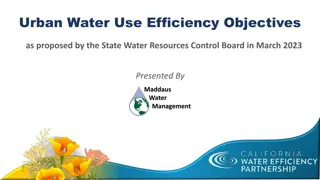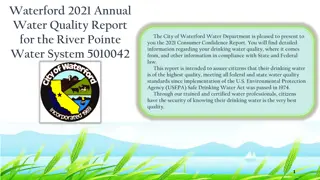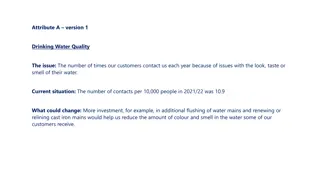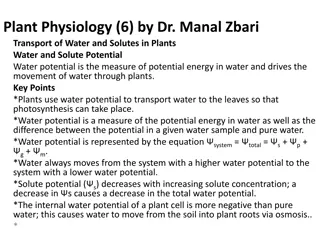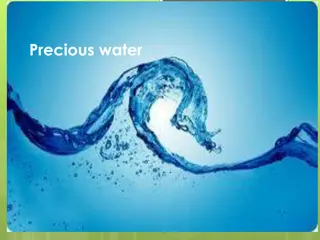
Water Quality Parameters and Classification
Explore the significance of water quality parameters, including physical and chemical aspects, classification of water sources, and the impact on human health. Learn about turbidity, temperature, contaminants, and more. Discover how water quality is crucial for life to thrive and the various categories of water based on safety and contamination levels.
Download Presentation

Please find below an Image/Link to download the presentation.
The content on the website is provided AS IS for your information and personal use only. It may not be sold, licensed, or shared on other websites without obtaining consent from the author. If you encounter any issues during the download, it is possible that the publisher has removed the file from their server.
You are allowed to download the files provided on this website for personal or commercial use, subject to the condition that they are used lawfully. All files are the property of their respective owners.
The content on the website is provided AS IS for your information and personal use only. It may not be sold, licensed, or shared on other websites without obtaining consent from the author.
E N D
Presentation Transcript
StudyMafia.Org Water Quality Parameters Submitted To: Submitted By: Studymafia.org Studymafia.org
Table Contents Definition Introduction Classification of Water Physical Parameters of Water Quality Chemical Parameters of Water Quality Conclusion 2
Definition Water is the second most important need for life to exist after air. 3
Introduction As a result, water quality has been described extensively in the scientific literature. The most popular definition of water quality is it is the physical, chemical, and biological characteristics of water . Water quality is a measure of the condition of water relative to the requirements of one or more biotic species and/or to any human need or purpose 4
Classification of Water Based on its source, water can be divided into ground water and surface water. Both types of water can be exposed to contamination risks from agricultural, industrial, and domestic activities, which may include many types of pollutants such as heavy metals, pesticides, fertilizers, hazardous chemicals, and oils 6
Classification of Water Potable water: It is safe to drink, pleasant to taste, and usable for domestic purposes Palatable water: It is esthetically pleasing; it considers the presence of chemicals that do not cause a threat to human health. Contaminated (polluted) water: It is that water containing unwanted physical, chemical, biological, or radiological substances. Infected water: It is contaminated with pathogenic organism 7
Physical Parameters of Water Quality Turbidity Turbidity is the cloudiness of water . It is a measure of the ability of light to pass through water. It is caused by suspended material such as clay, silt, organic material, plankton, and other particulate materials in water 8
Physical Parameters of Water Quality Temperature Palatability, viscosity, solubility, odors, and chemical reactions are influenced by temperature. Thereby, the sedimentation and chlorination processes and biological oxygen demand (BOD) are temperature dependent. It also affects the biosorption process of the dissolved heavy metals in water. 9
Physical Parameters of Water Quality Color Materials decayed from organic matter, namely, vegetation and inorganic matter such as soil, stones, and rocks impart color to water, which is objectionable for esthetic reasons, not for health reasons. 10
Physical Parameters of Water Quality Taste and odor Taste and odor in water can be caused by foreign matter such as organic materials, inorganic compounds, or dissolved gasses. These materials may come from natural, domestic, or agricultural sources. 11
Physical Parameters of Water Quality Solids Solids occur in water either in solution or in suspension. These two types of solids can be identified by using a glass fiber filter that the water sample passes through. By definition, the suspended solids are retained on the top of the filter and the dissolved solids pass through the filter with the water. 12
Chemical Parameters of Water Quality pH pH is one of the most important parameters of water quality. It is defined as the negative logarithm of the hydrogen ion concentration. It is a dimensionless number indicating the strength of an acidic or a basic solution. Actually, pH of water is a measure of how acidic/basic water is? 13
Chemical Parameters of Water Quality Acidity Acidity is the measure of acids in a solution. The acidity of water is its quantitative capacity to neutralize a strong base to a selected pH level. Acidity in water is usually due to carbon dioxide, mineral acids, and hydrolyzed salts such as ferric and aluminum sulfates. 14
Chemical Parameters of Water Quality Alkalinity The alkalinity of water is its acid-neutralizing capacity comprised of the total of all titratable bases. The measurement of alkalinity of water is necessary to determine the amount of lime and soda needed for water softening (e.g., for corrosion control in conditioning the boiler feed water). 15
Chemical Parameters of Water Quality Chloride Chloride occurs naturally in groundwater, streams, and lakes, but the presence of relatively high chloride concentration in freshwater (about 250 mg/L or more) may indicate wastewater pollution. Chlorides may enter surface water from several sources including chloride-containing rock, agricultural runoff, and wastewater. 16
Chemical Parameters of Water Quality Nitrogen There are four forms of nitrogen in water and wastewater: organic nitrogen, ammonia nitrogen, nitrite nitrogen, and nitrate nitrogen. If water is contaminated with sewage, most of the nitrogen is in the forms of organic and ammonia, which are transformed by microbes to form nitrites and nitrates. 17
Chemical Parameters of Water Quality Fluoride A moderate amount of fluoride ions (F ) in drinking water contributes to good dental health [10, 19]. About 1.0 mg/L is effective in preventing tooth decay, particularly in children. Excessive amounts of fluoride cause discolored teeth, a condition known as dental fluorosis. 18
Conclusion Parameters that are frequently sampled or monitored for water quality include temperature, dissolved oxygen, pH, conductivity, ORP, and turbidity. However water monitoring may also include measuring total algae, ISEs (ammonia, nitrate, chloride), or laboratory parameters such as BOD, titration, or TOC. 19
References Google.com Wikipedia.org Studymafia.org Slidespanda.com
Thanks To StudyMafia.org



